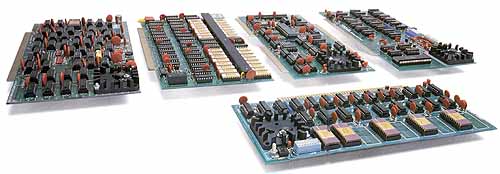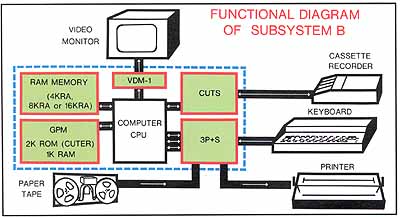Owners of Altair,
Imsai, Vector Graphic, Parasitic Engineering, Cromemco Z-2, TDL and other S-100
bus computers take heart! Discover the joys of an integrated system composed by
a master.

With the
exception of our own lovable Sol whose original design incorporated a systematic
approach to small computer development, all S-100 bus computers demand
additional hardware as well as software to get them up and on the air. Without a
memory module, the computer cannot handle large amounts of data. Without
input/output interfaces, it cannot receive data from a keyboard, transfer
information to a tv monitor or teletype printout, or store data on a cassette.
Without some elementary software routines built into the system, complex sets of
preliminary routines must be entered into the computer before it can coordinate
all these activities or load a simple program. In other words, a microcomputer,
technological miracle though it is, cannot be useful to any human being without
the help of further technological miracles.
In the past,
small computer enthusiasts have pieced together their systems purchasing one
component here, another there, and then found themselves struggling to make
everything work together.
Subsystem B,
a contemporary classic from Processor Technology, puts an end to all this
struggle and confusion. In one package, at a remarkably low price, we have
included a memory module, three input/output modules, a general purpose memory
and appropriate software. For those who prefer the finest craftsmanship over a
mess of parts. .
. for those who want the pleasure of running and
writing programs without clumsy preliminaries. . .
Subsystem B
offers a choice of three memory modules — 4KRA, 8KRA or 16KRA—
with four, eight or sixteen thousand bytes of memory for programs and data. The
VDM-1 module interfaces the computer with a tv monitor. The CUTS (the Computer
Users Tape System) module interfaces with a cassette recorder for program
loading and mass storage of up to 200,000 characters per C-60 cassette. For all
other communication to the outside world keyboard, teletype, printers and so
forth — 3P+S
provides three ports for data input or output.
The General
Purpose Memory (GPM) is a single piece of hardware/software which integrates the
functions of all the other modules. The software is preprogrammed onto IC chips
and provides instructions to operate the interfaces as well as set up elementary
operating commands for the system as a whole which can be entered through a
keyboard.
The block
diagram below shows how a system with a computer and all the Subsystem B
components would look.

The General Purpose Memory makes it all possible.
The key
concept underlying Subsystem B is inherent in the software which integrates the
overall functions of the hardware to create a system that is greater than the
sum of its parts. Processor Technology has developed and produced this software
as a program called CUTER.
CUTER ties
together the internal functions of the central computer as well as a cassette
recorder, keyboard, video display and other peripheral equipment. It also
brings standard commands to the system such as ENTER, DUMP, GET, EXECUTE
and CATALOG as well as custom commands. Furthermore, CUTER makes all Processor
Technology and Software Technology programs compatible with the system. CUTER
has been preprogrammed in Read Only Memory integrated circuits which reside on
the GPM board. It takes up 2,048 bytes of memory space. GPM also has a 1,024
byte area which is used as scratchpad.
Reserved
space is available on the GPM board for later addition of a powerful
ROM-resident assembler, the ALS-8. To simulate 8080 programs without running
them in real time, the SIM-l interpretive simulator can also be added. For
further flexibility, with SIM-1 comes our eminently useful TXT-2 text editor,
designed to make file editing quick and easy.
Load programs at a new tempo with CUTS.
For those
who are still loading programs via paper tape or flipping switches, CUTS will
bring a new tempo to system operations. A cassette recorder with CUTS interface
loads programs ten times faster than a TTY paper tape reader. Processor
Technology’s BASIC-5 program, which is included with CUTS, will load in just
58 seconds. We have also included two popular computer games on this tape.
CUTS is fully compatible with
the Byte/Kansas City standard; it will operate at either 300
or
1200 bits per second. Automatic Gain Control eliminates adjustments of the
cassette recorder volume or tone controls and minimizes bit drop-out in both
read and write modes.
Cassettes simplify data
storage because they are compact and can be filed away indefinitely without
deterioration. Information can be economically stored and then retrieved
quickly.
With CUTS, all Processor
Technology and Software Technology programs will run without modification on
any S-100 bus computer. CUTS provides the standardization which guarantees
availability of an ever increasing selection of compatible software.
Harmonious video interface VDM-1.
As the original video display
interface for S-100 bus systems, VDM-1 is still the most popular. It generates
sixteen 64-character lines in a large, easy-to-read, upper and lower case
typeface on any standard video monitor or modified tv set.
By utilizing a 1,024 byte
segment of system memory, VDM-1 provides extremely fast operation. For example,
any character on the screen can be accessed by the processor in microseconds.
Once the processor provides
the display status parameters, the VDM-1 can scroll its display upward or
downward at a top speed of about 1000 lines per minute.
The VDM-1 is versatile with
fully programmable cursor positioning. It will display black-on-white or
white-on-black, perfect for many video games. Software is included for terminal
mode operation in addition to the CUTER program.
I/O Versatility
with 3P+S.
Virtually all other
input/output needs of any S-100 bus computer are handled with ease by the 3P + S
module. No need to buy separate interfaces for serial and parallel devices; 3P
+S has both.
The serial port has a standard
RS-232 interface as well as standard current loop interface for teletypes and
various printers. The data rate is selectable up to 9600 baud.
One of the parallel ports sets
control conditions for the other ports as well as setting the serial I/O baud
rate. Two other 8-bit parallel ports will interface a keyboard or paper tape
reader with full handshaking logic.
The extraordinary versatility
of the 3P + S module allows it to accommodate virtually any type of peripheral
with only minor modifications. The addressing is selectable to any of 64 address
segments within the 8080 microprocessor’s range of 256 input/output addresses.